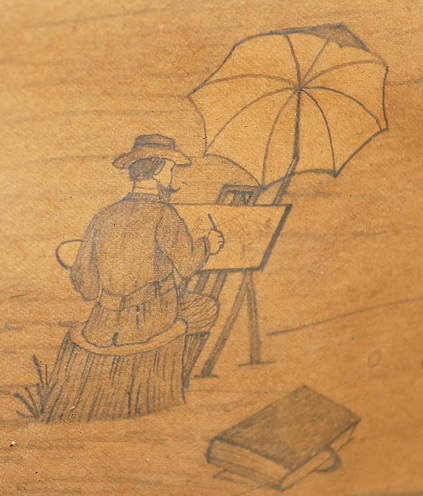 |
Ferdinand A. Brader | |
| Birth Date: December 7, 1833 |
||
| Death Date: December 20, 1901 Artist Gallery |
||
| Ferdinand A. Brader, an itinerant folk artist, wandered through Pennsylvania and Ohio, creating a legacy of drawings which provide a glimpse into daily life in rural America in the late 19th century. His drawings are treasured today by collectors of folk art and by scholars of American folk life, and certainly by the many families who cherish the stories of their great grandparents’ rural homes.
A native of northeast Switzerland, Brader came to America in the 1870s, around the age of 40, after a career of carving wooden bakery molds for the family bakery in his home village of Kaltbrunn. It is not known why he left Switzerland and his family behind or exactly when he arrived in America, but it is certain that he was in Berks County, Pennsylvania in 1879.
During his 16 years in America, Brader made at least 980 large drawings in graphite on commercial wove paper. These drawings by Brader span the years from 1879 in the Berks County, Pennsylvania area to 1895 in the Stark County, Ohio area. They are largely of farmsteads, but occasionally of commercial properties or public institutions, and usually bear careful inscriptions of his clients’ names, township, state, year and a sequential number. In 1892, he began to use colored pencils in addition to graphite, and many of his works in later years include color.
Families in Pennsylvania and Ohio pass down stories of a homeless artist who traded his detailed drawings for a few dollars and a place to sleep, usually in their barn. Contemporary newspaper accounts and records from the County Infirmaries confirm that Brader also spent the winter months in public infirmaries, commonly called Poor Houses.
In November 1895, while staying at the Stark County Infirmary, Brader received news of an inheritance of a small family fortune, and he soon left Ohio for the sea voyage back to Switzerland. His subsequent movements and whereabouts remain unknown until December 20, 1901 when Swiss court records declare Ferdinand Brader verschollen, “lost and missing without a trace”.
The Legacy of Ferdinand A. Brader remains evident in the pride of the descendants of the artist’s
clients as they continue to revel in the details of their ancestor’s farm lives. The historical significance of the drawings is evident to all who search them for clues to American folk life.
Kathleen Wieschaus-Voss
|
||


